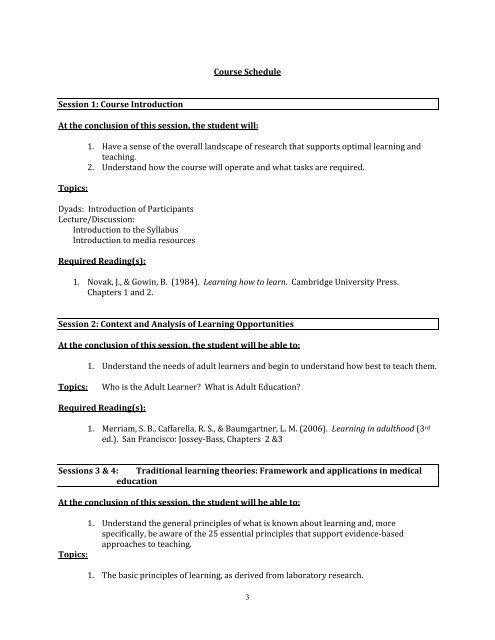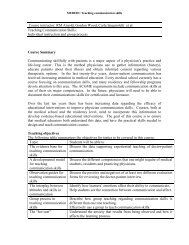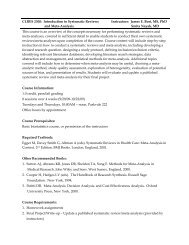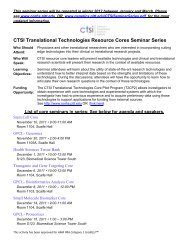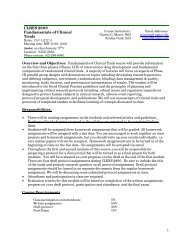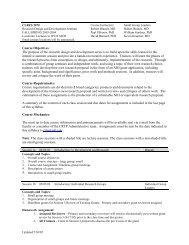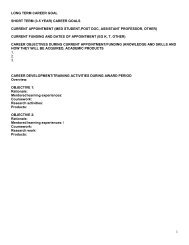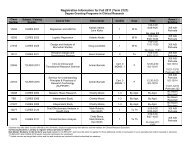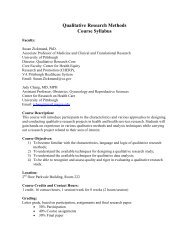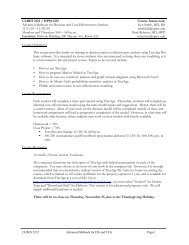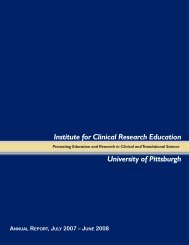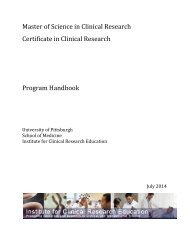should be based primarily on the text and preparatory readings from this course. Makesure to include at least 5 other citations of course readings, besides your textbook.Attendance Policy:Attendance is expected <strong>for</strong> each class session. Emergencies are the only acceptable excuse<strong>for</strong> missing class and in that case you must contact the instructors so we can makearrangements <strong>for</strong> you to make up the work you will miss.Students are expected to sign‐in to each class (computer provided in suite lobby). If aproblem is encountered with the sign‐in system, please contact the course instructor(s) aswell as Lauren Talotta (talottals@upmc.edu) immediately.Course Grading Scale:Normal graduate course grading will be used, with A indicating strong per<strong>for</strong>mance and Bindicating clearly acceptable per<strong>for</strong>mance.Required Textbook(s):Merriam, S. B., Caffarella, R. S., & Baumgartner, L. (2006). Learning in adulthood (3 rd ed.).San Francisco: Jossey‐Bass.Brans<strong>for</strong>d, John, Brown, Ann L., & Cocking, Rodney R. (Eds.). (1999). How People Learn:Brain, Mind, Experience, and School. Washington, D.C.: National Academy Press. Available <strong>for</strong>free online at http://www.nap.edu/openbook.php?isbn=0309070368Website resources:You will need concept mapping software. We recommend the program called CMAP, whichis available <strong>for</strong> free from cmap.ihmc.us/downloadAcademic Integrity:Students in this course will be expected to comply with the University of Pittsburgh's Policy onAcademic Integrity (http://www.provost.pitt.edu/info/ai1.html). Any student suspected ofviolating this obligation <strong>for</strong> any reason during the semester will be required to participate in theprocedural process, initiated at the instructor level, as outlined in the University Guidelines onAcademic Integrity. This may include, but is not limited to, the confiscation of the examination ofany individual suspected of violating University Policy. Furthermore, no student may bring anyunauthorized materials to an exam, including dictionaries and programmable calculators. In teamassignments, it is expected that all team members will participate substantially. In all assignments,it is expected that any work of others will be appropriately cited.2
Course ScheduleSession 1: Course IntroductionAt the conclusion of this session, the student will:Topics:1. Have a sense of the overall landscape of research that supports optimal learning andteaching.2. Understand how the course will operate and what tasks are required.Dyads: Introduction of ParticipantsLecture/Discussion:Introduction to the SyllabusIntroduction to media resourcesRequired Reading(s):1. Novak, J., & Gowin, B. (1984). Learning how to learn. Cambridge University Press.Chapters 1 and 2.Session 2: Context and Analysis of Learning OpportunitiesAt the conclusion of this session, the student will be able to:1. Understand the needs of adult learners and begin to understand how best to teach them.Topics:Who is the Adult Learner? What is Adult <strong>Education</strong>?Required Reading(s):1. Merriam, S. B., Caffarella, R. S., & Baumgartner, L. M. (2006). Learning in adulthood (3 rded.). San Francisco: Jossey‐Bass, Chapters 2 &3Sessions 3 & 4: Traditional learning theories: Framework and applications in medicaleducationAt the conclusion of this session, the student will be able to:1. Understand the general principles of what is known about learning and, morespecifically, be aware of the 25 essential principles that support evidence‐basedapproaches to teaching.Topics:1. The basic principles of learning, as derived from laboratory research.3


